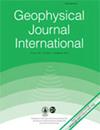西澳大利亚洲内坎宁盆地下异常肥沃的次大陆岩石圈地幔
IF 2.8
3区 地球科学
Q2 GEOCHEMISTRY & GEOPHYSICS
引用次数: 0
摘要
摘要 许多大陆内盆地是通过大陆岩石圈长期、缓慢的下沉而形成的宽阔洼地。这种长寿盆地可以记录数亿年的岩石圈过程,是岩石圈演化的重要档案。自中新生代大陆合并以来,大陆内部坎宁盆地下的岩石圈经历了多次构造事件,不同的上地壳数据集证明了广泛的地壳再加工。然而,人们对次大陆岩石圈地幔的结构缺乏了解。因此,理解表层和深层岩石圈过程之间的耦合演化,对于解决盆地的形成、发展和生存至关重要,但仍然是个问题。在此,我们在热力学建模框架内结合地球化学、地球物理和岩石物理数据,确定了坎宁盆地下岩石圈和亚岩石圈地幔的热化学性质、流变学、密度和地震结构。结果表明,岩石圈厚而坚硬,最大厚度为 185 千米,强度约为 1 美元乘以 1013 帕米,亚大陆岩石圈地幔异常富集铁,镁含量为 88.6。这种地幔结构与碰撞前的碎片或前寒武纪碰撞环境不一致,可能反映了大体积岩浆事件中的岩浆再营养过程。潜在的候选事件有:1070 Ma ∼ Warakurna、825 Ma ∼ Gairdner 和 510 Ma ∼ Kalkarindji 大火成岩省。其中最年轻的一个在时间和空间上与坎宁盆地的形成相关,因此被解释为影响了坎宁盆地的形成。我们认为,再营养作用造成了负浮力的次大陆岩石圈地幔,延长了盆地的沉降和保存时间,而坚固的岩石圈则确保了岩石圈的稳定性和长久性。本文章由计算机程序翻译,如有差异,请以英文原文为准。
Anomalously fertile subcontinental lithospheric mantle beneath the intracontinental Canning Basin, Western Australia
Summary Many intracontinental basins form as broad depressions through prolonged, slow subsidence of the continental lithosphere. Such long-lived basins can record lithospheric processes over hundreds of millions of years, serving as important archives of lithospheric evolution. Since continental amalgamation in the Mesoproterozoic, the lithosphere beneath the intracontinental Canning Basin has been subject to several tectonic events, with extensive crustal reworking evidenced through different upper crust datasets. However, knowledge of the structure of the subcontinental lithospheric mantle is lacking. As a consequence, understanding the coupled evolution between surface and deep lithospheric processes, crucial to resolving basin formation, development, and survival, remains problematic. Here, we combine geochemical, geophysical, and petrophysical data within a thermodynamic modelling framework to determine the thermochemical properties, rheology, density, and seismic structure of the lithospheric and sublithospheric mantle beneath the Canning Basin. The results indicate a thick, rigid lithosphere with a maximum thickness of 185 km and strength of ca. 1$\times$1013 Pa m, and an anomalously Fe-enriched subcontinental lithospheric mantle with a Mg# of 88.6. This mantle structure is not consistent with pre-collisional fragments or a Precambrian collisional setting and may reflect magmatic refertilisation during high-volume mafic magmatic events. Potential candidate events are the ∼1070 Ma Warakurna, ∼825 Ma Gairdner, and ∼510 Ma Kalkarindji Large Igneous Provinces. The youngest of these is temporally and spatially correlated with and therefore interpreted to have influenced the Canning Basin formation. We propose that refertilisation caused a negatively buoyant subcontinental lithospheric mantle and prolonged subsidence and preservation of the basin, while the strong lithosphere ensured lithospheric stability and longevity.
求助全文
通过发布文献求助,成功后即可免费获取论文全文。
去求助
来源期刊

Geophysical Journal International
地学-地球化学与地球物理
CiteScore
5.40
自引率
10.70%
发文量
436
审稿时长
3.3 months
期刊介绍:
Geophysical Journal International publishes top quality research papers, express letters, invited review papers and book reviews on all aspects of theoretical, computational, applied and observational geophysics.
 求助内容:
求助内容: 应助结果提醒方式:
应助结果提醒方式:


